Handley Page Halifax
The Handley Page Halifax is a British Royal Air Force (RAF) four-engined heavy bomber of the Second World War. It was developed by Handley Page to the same specification as the contemporary twin-engine Avro Manchester.
| Halifax | |
|---|---|
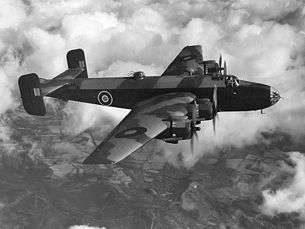 | |
| Handley Page Halifax B.III showing the later rectangular fins and Bristol Hercules radial engines | |
| Role | Heavy bomber |
| National origin | United Kingdom |
| Manufacturer | Handley Page |
| First flight | 25 October 1939 |
| Introduction | 13 November 1940 |
| Retired | 1961 (Pakistani Air Force) |
| Status | Retired |
| Primary users | Royal Air Force Royal Canadian Air Force Royal Australian Air Force Free French Air Force |
| Produced | 1940–1946 |
| Number built | 6,176[1]+ 2 HP.57 Prototypes |
The Halifax has its origins in the twin-engine HP56 proposal of the late 1930s, produced in response to the British Air Ministry's Specification P.13/36 for a capable medium bomber for "world-wide use." The HP56 was ordered as a backup to the Avro 679, both aircraft being designed to use the underperforming Rolls-Royce Vulture engine. The Handley Page design was altered at the Ministry to a four-engine arrangement powered by the Rolls-Royce Merlin engine; the rival Avro 679 was produced as the twin-engine Avro Manchester which, while regarded as unsuccessful mainly due to the Vulture engine, was a direct predecessor of the famed Avro Lancaster. Both the Lancaster and the Halifax would emerge as capable four-engined strategic bombers, thousands of which would be built and operated by the RAF and several other services during the War.
On 25 October 1939, the Halifax performed its maiden flight, and it entered service with the RAF on 13 November 1940. It quickly became a major component of Bomber Command, performing routine strategic bombing missions against the Axis Powers, many of them at night. Arthur Harris, the Air Officer Commanding-in-Chief of Bomber Command, described the Halifax as inferior to the rival Lancaster, in part due to its inability to carry larger individual bombs such as the 4,000 pound "Cookie" blast bomb. Nevertheless, production of the Halifax continued until April 1945. During their service with Bomber Command, Halifaxes flew a total of 82,773 operations and dropped 224,207 tons of bombs, while 1,833 aircraft were lost. The Halifax was also flown in large numbers by other Allied and Commonwealth nations, such as the Royal Canadian Air Force (RCAF), Royal Australian Air Force (RAAF), Free French Air Force and Polish forces.
Various improved versions of the Halifax were introduced, incorporating more powerful engines, a revised defensive turret layout and increased payload. It remained in service with Bomber Command until the end of the war, performing a variety of duties in addition to bombing. Additionally, specialised versions of the Halifax were developed for troop transport and paradrop operations. Following the end of the Second World War, the RAF quickly phased the Halifax out of service, after the type was succeeded in the strategic bombing role by the Avro Lincoln, an advanced derivative of the Lancaster. During the post-war years, the Halifax was operated by the Royal Egyptian Air Force, the French Air Force and the Royal Pakistan Air Force. The type also entered commercial service for a number of years, used mainly as a freighter. A dedicated civil transport variant, the Handley Page Halton, was also developed and entered airline service. 41 civil Halifax freighters were used during the Berlin Airlift. In 1961, the last remaining Halifax bombers were retired from operational use.
Development
Origins

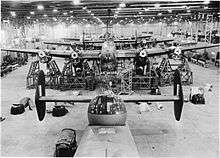
In the 1930s, the Royal Air Force (RAF) was primarily interested in twin-engine bombers.[2] These designs put significant demands on engine production and maintenance, both of which were already stretched with the introduction of many new types of aircraft into service. Power limitations were so serious that the British invested heavily in the development of huge engines in the 2,000 horsepower (1,500 kW) class in an effort to improve performance. However, during the late 1930s, none of these engines was ready for production. Meanwhile, both the United States and the Soviet Union were developing bombers powered by arrangements of four smaller engines with favorable results, including excellent range and fair lifting capacity. Accordingly, in 1936, the RAF decided to investigate the feasibility of a four-engined bomber.[2]
During the mid 1930s, the British Air Ministry released Specification P.13/36, seeking a twin-engine heavy-medium bomber suitable for "world-wide use".[3] Further requirements of the specification included the use of a mid-mounted cantilever monoplane wing and all-metal construction, and encouraged use of the Rolls-Royce Vulture engine then in development.[3] In response, Handley Page produced the twin-engine HP56 design to meet Specification P.13/36.[4] Handley Page aircraft designer George Volkert had responsibility for the design.
Other candidates were submitted for the same specification, including the Avro 679, and designs from Fairey, Boulton Paul and Shorts; all submissions were designed around two-engine configurations, using the Rolls-Royce Vulture, Napier Sabre, Fairey P.24 or Bristol Hercules engines. The majority of these engines were under development at this point; while four-engined bomber designs were considered for specification B.12/36 for a heavy bomber, wings mounting two pairs of engines were still in the experimental stage and required additional testing at the Royal Aircraft Establishment (RAE). Adopting a stronger wing also required additional strengthening of the overall aircraft structure, resulting in an increase in overall weight.[5]
In February 1937, following consideration of the designs, the Air Ministry selected Avro's submission, with Handley Page's bid chosen as "second string". Accordingly, during April 1937, the Air Ministry ordered two prototypes of each design.[6][3] The introduction of the successful P.13/36 candidates was delayed by the necessity of ordering additional Armstrong-Whitworth Whitley and Vickers Wellington bombers first. In mid-1937, it was decided to order both the Avro 679 and HP56 designs "off the drawing board" in order to speed up delivery timetables.
During July 1937, Handley Page was instructed to redesign the HP56 to use a four-engine arrangement, instead of the original twin-engine configuration; by this point, the Vulture had already been suffering from reliability and performance problems.[3] The rival Avro 679 proceeded into service as the Avro Manchester powered by a pair of Vulture engines, but was only built in limited quantities after suffering substantially from engine-related difficulties. The four-engine redesign increased its wingspan from 88 ft (27 m) to 99 ft (30 m) and added 13,000 pounds (5,900 kg) of weight.[3] In September 1937, the Ministry specified the use of four Rolls-Royce Merlin engines; according to aviation author Phillip J. R. Moyes, this redesign to four Merlin engines had been done "much against the company's wishes".[3]
Towards the end of the year, a full mock-up of the design was assessed; production of a pair of HP57 prototypes commenced in March 1938.[7] Further design modifications resulted in the definitive aircraft, now considerably enlarged and powered by four 1,280 hp (950 kW) Rolls-Royce Merlin X engines. Such was the promise of the new model that, in January 1938, the RAF chose to place their first production order for the type, ordering 100 Mk.I Halifaxes "off the drawing board", at which point the serials which had already been assigned to HP56 were switched to HP57.[3]
Prototypes
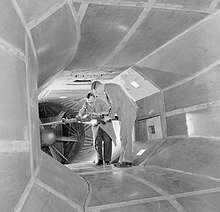
The first prototype was built at Handley Page's facility in Cricklewood, London, It was then dismantled and transported by road to RAF Bicester (the nearest non-operational RAF airfield with suitable facilities) for reassembly. On 25 October 1939, the maiden flight of the first prototype Halifax, serial number L7244, was performed by chief test pilot Jim Cordes with E A 'Ginger' Wright as flight test observer; during this flight, the undercarriage remained locked down as an extra safety precaution.[8][3]
On 17 August 1940, the first flight of the second prototype, L7245, now complete with full armament and operationally-representative equipment, was performed by Cordes from Radlett Aerodrome.[3] The HP57 was given the service name Halifax upon its acceptance. This name followed the practice of naming heavy bombers after major towns – in this case, Halifax in the West Riding of Yorkshire. In September 1941, a production Halifax Mk.I participated in an official naming ceremony of the type, officiated by Lord Halifax and Lady Halifax.[3]
Production
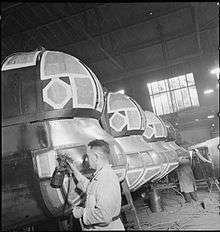
Series production of the Halifax began at Handley Page's factory at Cricklewood and at English Electric's site in Samlesbury, Lancashire. In order to speed up production, Handley Page implemented several new manufacturing techniques, including two pioneering approaches: photo-lofting and split construction. In the latter capacity, each Halifax was built from various sub-assemblies.[9] Surface panels were flush-riveted, although the application of the matt black night bomber camouflage probably negated its benefit.[10]
Handley Page built the assemblies and components at Cricklewood and the aircraft were assembled and flown from Radlett Aerodrome; the first production aircraft flew from Radlett on 11 October 1940.
The sizeable production run envisioned required the involvement of several external parties in addition to Handley Page.[9] The resulting Halifax Group was established to oversee the manufacturing programme, comprising English Electric (who had previously been a valued contributor in the production of the Handley Page Hampden), various firms within the London Aircraft Production Group, Fairey Aviation, and Rootes Motors.[9] Because of this scheme and other initiatives, the Halifax was manufactured by a variety of aviation companies at sites across the British isles.
The Halifax was produced in large numbers during the war: of the 10,018 heavy bombers produced in Britain between 1940 and 1944, 4,046 were various models of the Halifax – in excess of 40%.[9] In all, 6,178 Halifaxes were built, the last delivered in April 1945.[11][9] At the peak, 41 separate factories and dispersed units were involved in production, along with 600 subcontractors and 51,000 employees, with one Halifax completed every hour.[9] The first English Electric-built aircraft was flown from Samlesbury on 15 August 1941.
The first production standard Halifax, the Mk.I, had a 22 ft (6.7 m) long bomb bay as well as six bomb cells in the wings, providing a bomb capacity of 13,000 lb (5,900 kg). Defensive armament consisted of two .303 in (7.7 mm) Browning machine guns in a Boulton Paul Type C nose turret, with an additional four in a Boulton Paul Type E tail turret. Some aircraft included two additional .303 in (7.7 mm) Vickers K machine guns in beam (side, or "waist") positions. Subtle modifications distinguished the Mk I aircraft. Aircraft of the first batch of fifty Mk I Halifaxes were designated Mk I Series I.
Factories
| Manufacturer | Location | Number produced |
|---|---|---|
| Handley Page | Radlett | 1589 |
| English Electric | Preston | 2145 |
| Fairey Aviation | Stockport | 662 |
| London Aircraft Production Group | Leavesden[lower-alpha 1] | 710 |
| Rootes Securities | Speke | 1070 |
Improvements
The Halifax Mk.I was quickly followed by 25 of the Mk I Series II; these featured an increased gross weight (from 58,000 lb/26,310 kg to 60,000 lb/27,220 kg) but with maximum landing weight unchanged at 50,000 lb (23,000 kg). The Halifax Mk I Series III featured increased fuel capacity (1,882 gal/8,556 L), and larger oil coolers, the latter of which having been adopted in order to accommodate the Merlin XX engine. A dorsally-mounted two-gun Boulton Paul Type C turret replaced the beam guns.[12]
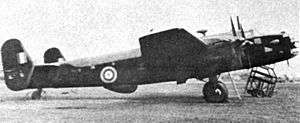
Introduction of 1,390 hp (1,040 kW) Merlin XX engines and a twin .303 in (7.7 mm) dorsal turret instead of waist guns resulted in the Halifax B Mk II Series I. The Mk II Series I (Special) achieved improved performance via the removal of the nose and dorsal turrets. The Halifax Mk II Series IA was fitted with a moulded Perspex nose (this nose became standard upon future Halifax variants), a four-gun Defiant-type dorsal turret, Merlin 22 engines and larger, trapezoidal-shaped vertical tail surfaces which solved control deficiencies from fin-stall produced by the roughly triangular-shape original surfaces, leading to rudder overbalance in the early marks.[13][14] Halifax IIs were built by both English Electric and Handley Page; 200 and 100 aircraft respectively.
Owing to a shortage of Messier-built landing gear and hydraulics, Dowty-built landing gear were used on some aircraft instead. As it was incompatible with the Messier equipment, this led to these Halifax bombers being given new designations: a Mark II built with Dowty gear was the Mark V.[12] The use of castings rather than forgings in the Dowty undercarriage had resulted in an increased production rate but had also led to a reduced landing weight of 40,000 lb (18,000 kg). The Halifax Mark V were manufactured by Rootes Group at Speke and Fairey at Stockport; operationally, these were generally used by Coastal Command and for training purposes. Some 904 had been built when Mark V production ended at the start of 1944,[15] compared to 1,966 Halifax Mk IIs.
The most numerous Halifax variant was the B Mk III of which 2,091 were built. First appearing in 1943, the Mk III featured the Perspex nose and modified tail of the Mk II Series IA but replaced the Merlin with the more powerful 1,650 hp (1,230 kW) Bristol Hercules XVI radial engine. Other changes included the adoption of de Havilland Hydromatic propellers and rounded wing tips.[12] The Halifax Mk IV was a non-production design using a turbocharged Hercules powerplant.
The definitive version of the Halifax was the B Mk VI, powered by the 1,800 hp (1,300 kW) Hercules 100. The final bomber version, the Mk VII, reverted to the less powerful Hercules XVI. However, these variants were produced in relatively small quantities.
The remaining variants were the Halifax C Mk VIII, an unarmed transport that was fitted with an 8,000 lb/3,630 kg cargo pannier instead of a bomb bay, which could accommodate a maximum of 11 passengers and the Mk A IX paratroop transport, which had space for up to 16 paratroopers and their equipment. A transport/cargo version of the Halifax was also produced, known as the Handley Page Halton.[16]
Design
Overview

The Handley Page Halifax was a mostly orthodox design, a mid-wing monoplane with a tail unit featuring twin fins and rudders. The Halifax featured all-metal construction with a smooth, stressed skin covering the majority of the exterior surfaces; the flight control surfaces were an exception, being fabric-covered instead.[3] The slab-sided fuselage contained a 22-foot bomb bay, which contained the majority of the Halifax's payload, while the cockpit was flush with the upper fuselage.[3]
The Halifax was powered by four engines, two spaced evenly on each wing.[3] Early production Halifax bombers were powered by models of the Rolls-Royce Merlin engine; later aircraft were commonly powered by the larger Bristol Hercules radial engine. To contain and attach the engines to the airframe, Handley Page developed their own design for the power egg instead of using the typical, slimmer Rolls-Royce counterpart; despite generating increased drag, this in-house design was readily adaptable to the alternative Hercules engine on later aircraft.[3]
Each engine drove a Rotol-built compressed wood constant-speed propeller, enabling the Halifax B.I to attain a maximum speed of 265 mph at 17,500 feet.[17] With a typical payload of 5,800 lbs of bombs and 2,242 imp. gal. of fuel, it had a range of 1,860 miles. The defensive armaments included power-assisted gun turrets in various positions located across the aircraft.[9] Different models of the Halifax used different numbers and combinations of turrets, effectively trading speed for firepower and vice versa.[9]
Accommodation and armament
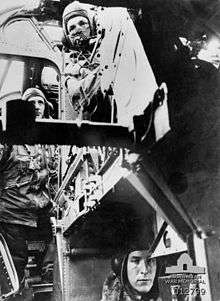
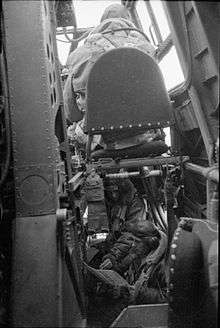
The bomb aimer's position was in the extreme nose with the navigator's table located behind it, both roles fulfilled by the same crew member. Above the navigator's position was the forward gun turret. The wireless (radio) operator was behind the navigator's position, separated by a half-width partition.[18]
The pilot (left side) and co-pilot (right side) occupied the cockpit, above the wireless operator. (The flight engineer filled in as a co-pilot, seated on a folding seat, during crucial manoeuvres such as take-off.) Aft of the pilots and on the same level as the navigator and wireless operator was the flight engineer's compartment. Another compartment aft of the flight engineer contained two bunks originally intended for resting crew members, but almost always used for treating and berthing injured crew. This area led to the two-gun dorsal turret. The tail gunner occupied a four-gun turret at the extreme aft end of the aircraft.[18]
Starting with the Halifax Mk II Series IA and from the Mk III onwards, the nose turret was deleted; instead the bomb-aimer occupied a streamlined perspex nose containing a single hand-held machine gun. On later-built aircraft, the two-gun dorsal turret was replaced by a four-gun Boulton Paul turret.
The maximum bomb load was 14,500 lb (6,600 kg), which was primarily carried in a bomb bay housed within the fuselage, divided into six separate bomb compartments, with three bomb compartments in the inboard sections of each wing; this division of the payload between multiple compartments limited the maximum size of the individual bombs which could be carried to 2,000 lb (910 kg).
Operational service

In November 1940, the Handley Page Halifax entered service with No. 35 Squadron at RAF Linton-on-Ouse. Its operational debut occurred on the night of 10–11 March 1941, when six Halifax bombers flew a bombing raid against Le Havre, targeting the area around the docks and any shipping that might be present.[9][19] The existence of the Halifax was not officially acknowledged until July 1941, after it was used in a daylight attack on La Pallice, France, against the German battleship Scharnhorst. At the end of 1941, the Halifax was withdrawn from daylight bombing operations after intensifying fighter opposition had increased the casualty rates to unsustainable levels.[9]
In the second half of 1942, No. 35 Squadron and four other squadrons were selected to form the Pathfinder Force, later expanded to become No. 8 Group.[9] Pathfinder crews flying the Halifax would mark routes and identify and mark targets for the Main Force. Effective marking greatly increased the accuracy and destructive power of Bomber Command. As a Pathfinder and Main Force aircraft, the Halifax was a core part of the bombing offensive against Germany and its Axis allies.[20]
By the end of 1943, No. 4 Group had been entirely equipped with the Halifax, and would continue to operate the aircraft until the end of the war.[9] The No. 6 Group of the Royal Canadian Air Force (RCAF) also adopted the Halifax around the same time, and would go on to operate it in each of its 14 squadrons, although it was never solely equipped with the type. At its peak strength, Bomber Command operated a total of 76 Halifax-equipped squadrons.[9]

While the early-built models of the Halifax were heavily used by Bomber Command and made valuable contributions to operations, the aircraft's performance was considered unsatisfactory for the most part, mainly due to the underpowered Merlin engine, which meant that it could not fly at the higher altitudes needed to avoid enemy fighters, which were becoming increasingly effective throughout 1943.[12] This was answered by the Halifax Mk III, which was powered by Bristol Hercules radial engines in place of the Merlins. Introduced into service in November 1943, the Mk III was first delivered to No. 433 Squadron and No. 466 Squadron.[21] By January 1944, the Hercules-powered Halifax was available in quantity and quickly proved to have superior performance in the face of German fighter defences.[12]
Early on, Air Chief Marshal Arthur Harris, head of Bomber Command, was scathing in his criticism of the Halifax's performance in comparison to the new Avro Lancaster, primarily of its bomb-carrying capability: an average Halifax was calculated to drop 100 tons of bombs in its lifetime, compared to a Lancaster's 154. Harris continued to have a poor opinion of the Halifax, despite the fact that later Hercules-engined machines had lower loss rates and higher crew survival rates after abandoning the aircraft than Lancasters, and came very close to the Lancaster's speed and altitude performance.[22] Unlike the Lancaster, the Halifax's bomb bay could not be adapted to carry the 4,000 pound "Cookie" blast bomb, which was an integral part of Harris's fire-bombing tactics. The Halifax was progressively outnumbered in front-line service over occupied Europe as more Lancasters became available from 1943 onwards; many squadrons converted to the Lancaster.[note 1]
Production of the Halifax continued, supposedly because it was more efficient to keep building it than to stop its production and convert to building another aircraft. But any new facilities were devoted to the Lancaster.
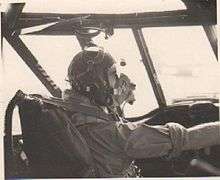
Harris's view of the Halifax changed sometime after spring 1942. On 2 June 1942, in a response to a telegram sent by Frederick Handley Page, congratulating Harris on the success of the first 1000 bomber Cologne raid, he stated: "My Dear Handley Page. We much appreciate your telegram of congratulation on Saturday night's work, the success of which was very largely due to your support in giving us such a powerful weapon to wield. Between us we will make a job of it."[23]
Following the invasion of Europe in 1944, the Halifax resumed daylight bombing operations, performing semi-tactical strikes upon enemy troop concentrations, gun emplacements, and strongpoints along the French coastline with a reportedly high degree of accuracy.[24] Other common targets were enemy communications and the launch sites for V-1 flying bombs. Bombing activity became increasingly brazen throughout late 1944 as the Luftwaffe became incapable of putting up effective opposition against them.[24] The Halifax also found itself being increasingly tasked with transport duties around this time; in one instance, around half a million gallons of petrol was delivered to Brussels in support of the advancing Second Army, then engaged in heavy fighting at Arnhem.[24]
During the latter half of 1944, the bombing of German-held oil facilities became a major priority of the offensive.[24] On 27 August, a force of 216 Halifax bombers, alongside smaller numbers of de Havilland Mosquitos and Lancasters and a sizable escort of Supermarine Spitfires, conducted the first major daylight operation by Bomber Command against a target inside Germany that year, attacking the oil refinery at Homberg on the Ruhr. In spite of heavy fire from anti-aircraft defenses, no bombers were downed and the refinery was severely damaged in places.[25] Attacks upon oil production facilities throughout Germany would become commonplace within the remaining months of the war.[26]

The only Victoria Cross to be awarded to any Halifax pilot went to Cyril J. Barton of No. 578 Squadron for displaying great gallantry in bringing his heavily damaged aircraft back after a raid on Nuremberg on the night of 30/31 March 1944. Barton continued to fly the Halifax while other crew members bailed out, he was killed in the aircraft's crash-landing, but the remaining crew survived due to his actions.[24]

Large numbers of Halifax bombers were also operated by Coastal Command, which used it to conduct anti submarine warfare, reconnaissance and meteorological operations. The Halifax was heavily used to deploy mines in the vicinity of enemy-held ports.[26] It served increasingly in other support capacities as the war progressed, being used as a glider tug, an electronic warfare aircraft for No. 100 Group and to conduct special operations, such as parachuting agents and arms into occupied Europe, for the Special Operations Executive (SOE).[27]
Throughout early 1945, the Halifax was frequently dispatched against cities within the German homeland, including Hannover, Magdeburg, Stuttgart, Cologne, Münster, Osnabrück and others.[26] During these months, infrastructure such as oil facilities and railways were given a high priority; these targets were attacked right up until the end of the war. According to Moyes, within the final few months, bomber losses had fallen to all-time lows while raids were frequently regarded as having been highly successful.[26] During the final months of the war the improved Halifax Mk VI and Mk VII were introduced. In particular, these models had been 'tropicalised' with an eye towards their potential use in the Pacific War against the Empire of Japan.[26] While some of these Mk VI and Mk VII machines were deployed to the theatre, they played little meaningful role as the war ended before larger numbers could be brought to bear against Japanese forces.[28]
On 25 April 1945, the Halifax performed its last major operation against the enemy during an attack upon coastal gun batteries on Wangerooge in the Frisian Islands of the North Sea.[29] While the type continued to fly operations after this, these were primarily diversions to other operations and sporadic, uncoordinated attacks against targets of opportunity. Upon the end of the conflict, Bomber Command quickly disbanded the majority of its Halifax-equipped squadrons; the aircraft themselves were transferred to Transport Command.[27] During the type's service with Bomber Command, Halifaxes flew 82,773 operations and dropped 224,207 tons of bombs. 1,833 aircraft were lost.[30][31]
By 1947, the majority of Halifax bombers were deemed to be surplus and scrapped.[27] The Halifax remained in widespread service with Coastal Command and RAF Transport Command, Royal Egyptian Air Force and the Armée de l'Air until early 1952. The Pakistan Air Force, which had inherited a number of Halifax bombers from the RAF, also continued to operate them and become the last military user of the type, retiring the last aircraft in 1961.
In September 1997 Halifax 57 Rescue of Canada excavated Halifax LW682 from a bog near the River Dender in Belgium. The plane was part of RCAF 426 Squadron, and had been shot down near Geraardsbergen during a raid on Leuven, Belgium on 12 May 1944. During the excavation, the bodies of three crew members were recovered and later given proper burial. Several items from the plane were used in restoration of NA337, while other items were transferred to museums. The airframe was melted down and used to construct the ceiling of the RAF Bomber Command Memorial in London, which was unveiled in 2012.[32]
Civilian operation

A number of former RAF Halifax C.8s were sold from 1945 and used as freighters by a number of mostly British airlines. In 1948, 41 civil Halifax freighters were used during the Berlin Air Lift, operating a total of 4,653 sorties carrying freight and 3,509 carrying bulk diesel fuel. Nine aircraft were lost during the airlift. The Low-cost airline business pioneer Freddie Laker bought and serviced war-surplus Halifaxes for Bond Air Services operations in the Berlin airlift.
With the airfreight market in decline, most of the civilian Halifaxes were scrapped on their return to England. The last civilian-operated Halifaxes were withdrawn from service in late 1952.
Variants

Pre-Halifax designs
- H.P.55
- Proposed twin-engine bomber aircraft, never built.
- H.P.56
- Proposed twin-engine bomber aircraft, fitted with two Rolls-Royce Vulture engines, never built.
H.P.57
- HP.57
- L7244 – Prototype first flew on The first Halifax prototype with four Merlin 10 engines and no armament.
- L7245 – Second prototype first flew from Radlett on 17 August 1940 and was more representative of the production configuration including armament.
- Halifax B.I Series I
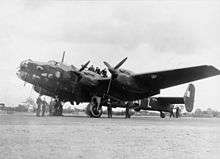
- Four-engined long-range heavy-bomber aircraft powered by Rolls-Royce Merlin engines; the first production version. Armament consisted of nose turret with two guns, tail turret with four guns and two beam guns
- Halifax B.I Series II
- Stressed for operating at a higher gross weight.
- Halifax B.I Series III
- Re-engined with Merlin XX engines, introduced new upper turret in place of beam guns, with revised undercarriage and additional centre-section fuel tanks.
H.P.58
- Halifax Mk II
- Projected variant with revised armament including 20 mm cannon and no tail turret. Due to problems with the new armament, the project was cancelled and the Mk II designation given to H.P.59.
H.P.59
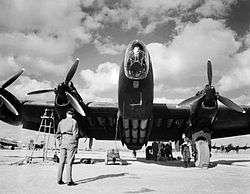
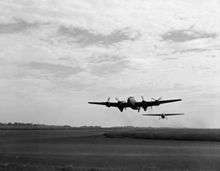
- Halifax Mk II
- New variant with increased takeoff weight, fuel and weapons carriage.
- Halifax B.II Series I
- First series of the bomber variant; from March 1942 onwards, these were fitted with TR1335 navigation aids.
- Halifax B.II Series I (Special), SOE
- Special version for Special Operations Executive (SOE) used to drop supplies over Europe. Nose armament and dorsal turret removed, the nose being faired over, as well as changes to the fuel vent pipes and exhaust shrouds.
- Halifax B.II Series I (Special)
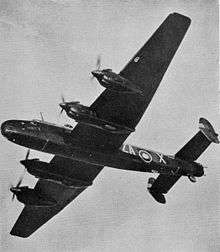
- Generally similar to the aircraft used by the SOE, these were employed in the bombing role. These aircraft were more varied in appearance, especially concerning the fitting of dorsal armament with some aircraft retaining the standard Boulton Paul "Type C" turret in different mounts with others mounting a "Type A" turret. There were also examples with no dorsal turret, similar to the SOE-aircraft.
- Halifax B.II Series IA
- Modified with new glazed nose section, new radiators and new "D" fin and rudder. The dorsal turret was changed to a four-gun Boulton Paul Type A Mk VIII, and there were improvements to the bomb bay door sealing. Some aircraft were fitted with the H2S radar.
- Halifax B.II Series I, Freighter
- A few Mk IIs were employed in the transport role in Great Britain (unmodified SOE-aircraft) and in the Middle East (simple modifications to allow carriage of engines or Spitfire fuselages).
- Halifax B.II Series II
- Single aircraft (HR756) modified with three-blade Rotol propellers and Merlin 22 engines. Rejected in favour of Mk III.
- Halifax A.II
- According to some sources, a handful of the airborne forces Halifaxes were converted into B.IIs. If this is true they might have been designated A.II or may have retained their bomber designations.[33]
- Halifax GR.II
- Coastal Command variant of the Halifax B.II.
- Halifax GR.II Series I
- A handful of aircraft converted from Series I or Special to GR.II standard, having differences in dorsal armament. The main difference was the fitting of a ASV.Mk 3 radar in an H2S type fairing. Sometimes, a .50 in (12.7 mm) machine gun was fitted in the faired nose.
- Halifax GR.II Series IA
- Definitive Coastal Command variant of the GR.II with glazed nose mounting .50 in (12.7 mm) machine gun, Merlin XX or 22 engines, B-P A-type dorsal turret and extra long-range fuel tanks in fuselage. A ventral turret holding a single .50 in (12.7 mm) machine gun was mounted on most aircraft although some employed the ASV.Mk 3 radar in its place.
- Halifax Met.II
- Some sources[34] suggest that there were a meteorological variant of the B.II, designated Met.II, but this is unlikely.[35]
H.P.61
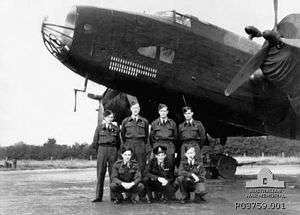
- Halifax B.III
- Main production variant, fitted with Bristol Hercules engines. B.III bombers were fitted with transparent nose dome with single machine gun, Boulton Paul dorsal turret with four guns and tail turret with four guns. All but first few had longer wing with rounded wingtips that increased wingspan to 104 ft 2 in (31.75 m).
- Halifax A.III
- Halifax B.III bombers converted into glider tug and paratroop transport aircraft.
- Halifax C.III
- Halifax B.III bombers converted into military transport aircraft.
H.P.63

_Group_RAF._CH14887.jpg)
- Halifax B.V
- Four-engined long-range heavy-bomber, powered by four Rolls-Royce Merlin XX engines with square empennage and wingtips. Armament as B.III
- Halifax B.V Series I (Special)
- Halifax A.V
- Halifax B.V bombers converted into glider tugs and paratroop transport aircraft.
- Halifax GR.V
- Coastal Command variant. Halifax B.V bombers converted into maritime reconnaissance aircraft.
- Halifax B.VI
- Four-engined long-range heavy-bomber, powered by four 1,615 hp (1,204 kW) Bristol Hercules XVI radial engines with H2S radar. No dorsal turret. Square empennage, round wing tips.
- Halifax C.VI
- Halifax B.VI bombers converted into military transport aircraft.
- Halifax GR.VI
- Coastal Command variant. Halifax B.VI bombers converted into maritime reconnaissance aircraft.
- Halifax B.VII
- Four-engined long-range heavy-bomber, powered by four 1,615 hp (1,204 kW) Bristol Hercules XVI radial engines. Round wing tips. Armament as B.III
- Halifax A.VII
- Halifax B.VIIs converted into paratroop transport and glider tug aircraft.
- Halifax C.VII
- Halifax B.VIIs bombers converted into military transport aircraft.
H.P.70
- Halifax C.VIII
- Cargo and passenger transport aircraft.
H.P.71
- Halifax A.IX
- Paratroop transport, glider tug aircraft.
H.P.70 Halton
- Halton I
- Interim civil transport version; postwar, a number of Halifax bombers were converted into civilian transport aircraft.
- Halton II
- VIP transport aircraft for the Maharajah Gaekwar of Baroda.
Operators
Military operators
.jpg)
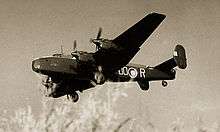
.jpg)
- Royal Canadian Air Force[37]
- No. 405 Squadron RCAF
- No. 408 Squadron RCAF
- No. 415 Squadron RCAF
- No. 419 Squadron RCAF
- No. 420 Squadron RCAF
- No. 424 Squadron RCAF
- No. 425 Squadron RCAF
- No. 426 Squadron RCAF
- No. 427 Squadron RCAF
- No. 428 Squadron RCAF
- No. 429 Squadron RCAF
- No. 431 Squadron RCAF
- No. 432 Squadron RCAF
- No. 433 Squadron RCAF
- No. 434 Squadron RCAF
- Free French Air Forces[36]
- No. 346 Squadron RAF (GB II/23 Guyenne)
- No. 347 Squadron RAF (GB I/25 Tunisie)
- Pakistan Air Force[39]
- No. 12 Squadron
- Polish Air Forces in exile in Great Britain[40]
- No. 301 Polish Bomber Squadron
- C Flight No. 138 Squadron RAF, later No. 1586 (Polish Special Duties) Flight before reforming as 301 Squadron Special Duties
- No. 304 Polish Bomber Squadron RAF
- Royal Air Force[41]
- No. 10 Squadron RAF
- No. 35 Squadron RAF
- No. 47 Squadron RAF
- No. 51 Squadron RAF
- No. 58 Squadron RAF
- No. 76 Squadron RAF
- No. 77 Squadron RAF
- No. 78 Squadron RAF
- No. 96 Squadron RAF
- No. 102 Squadron RAF
- No. 103 Squadron RAF
- No. 108 Squadron RAF
- No. 113 Squadron RAF
- No. 138 Squadron RAF
- No. 148 Squadron RAF
- No. 158 Squadron RAF
- No. 161 Squadron RAF
- No. 171 Squadron RAF
- No. 178 Squadron RAF
- No. 187 Squadron RAF
- No. 190 Squadron RAF
- No. 192 Squadron RAF
- No. 199 Squadron RAF
- No. 202 Squadron RAF
- No. 224 Squadron RAF
- No. 246 Squadron RAF
- No. 295 Squadron RAF
- No. 296 Squadron RAF
- No. 297 Squadron RAF
- No. 298 Squadron RAF
- No. 502 Squadron RAF
- No. 517 Squadron RAF
- No. 518 Squadron RAF
- No. 519 Squadron RAF
- No. 520 Squadron RAF
- No. 521 Squadron RAF
- No. 578 Squadron RAF
- No. 614 Squadron RAF
- No. 620 Squadron RAF
- No. 624 Squadron RAF
- No. 640 Squadron RAF
- No. 644 Squadron RAF
Civil operators
- Aircarrier (Former Wikner aircraft)
- Geoffrey Wikner (B.III converted with a 15-passenger interior)
- Aero Cargo
- CTAI
- SANA (Societe Anonyme de Navigation Aeriennes)
- Peteair
- Vingtor Airways
- Alpha Airways
- LAMS (South Africa)
- Air Globe
- Air Freight
- Airtech
- Bond Air Services
- British American Air Services
- British Overseas Airways Corporation
- Chartair
- C.L. Air Surveys
- Eagle Aviation
- Lancashire Aircraft Corporation
- London Aero and Motor Services (LAMS)
- Payloads
- Skyflight
- Union Air Services
- V.I.P. Services
- Westminster Airways (converted as a bulk fuel carrier for Berlin Airlift)
- World Air Freight
Halton operators
- Maharajah Gaekwar of Baroda
- Louis Breguet
- Alpha Airways
- Bond Air Services
- British American Air Services
- British Overseas Airways Corporation
- Westminster Airways
- Worldair Carrier
Surviving aircraft
Of the 6,176 Halifaxes built, only three complete planes remain.
| Serial | Geographic location | Institutional location | History | Photo |
|---|---|---|---|---|
| NA337 | Trenton, Ontario | National Air Force Museum of Canada | Built by Rootes Motors. Delivered to 644 Squadron at RAF Tarrant Rushton 5 March 1945. On 24 March 1945 it towed a glider as part of Operation Varsity – the airborne operation in support of crossing the Rhine. Completed three supply drops in Norway and Denmark in March and April 1945. On the fourth sortie, 23 April 1945, piloted by Alexander Turnbull, NA337 was sent to drop 13 supply containers and two packages at Mikkelsberget, Norway. After a successful drop, it was hit by flak in the starboard wing at 0131 hours on 24 April. After both starboard engines caught fire, NA337 ditched in Lake Mjøsa at 0145 hours. All but one crew member, Thomas Weightman, died of hypothermia. It was discovered in 1991 by Tore Marsoe and Rolf Liberg, and further raised in 1995 by Halifax 57 Rescue. Restoration was completed in November 2005.[42] |  |
| HR792 | Elvington, North Yorkshire | Yorkshire Air Museum | Built by Handley Page. 58 Squadron. Flew 67 sorties between 15 July 1943 and 9 December 1944. Crash landed near Stornoway, 13 January 1945. Fuselage was purchased by a chicken farmer and used as a coop. Recovered and restored in 1984 using parts from Halifaxes LW687 and JP158 as well as wings from Hastings TG536. Painted as LV907 "Friday the 13th" of 158 Squadron.[43] |  |
| W1048 | Colindale, London | RAF Museum London | Built by English Electric. Assigned to 102 Squadron at RAF Topcliffe on 27 March 1942. Sent to 35 Squadron at RAF Linton-on-Ouse on 9 April 1942. On 27 April 1942, it was one of 31 Halifaxes that flew from RAF Kinloss as part of raid on the German battleship Tirpitz. W1048 made her attack at 0300 hours, during which she was hit by the intense flak which set the outer starboard engine on fire. Pilot Don MacIntyre completed a wheels-up landing on frozen Lake Hoklingen in Norway but the aircraft sank 12 hours later. It was discovered by divers in 1971 and subsequently recovered on 30 June 1973 by the RAF Sub-Aqua Association. It has been left unrestored.[44] |  |
Specifications (Mk III)
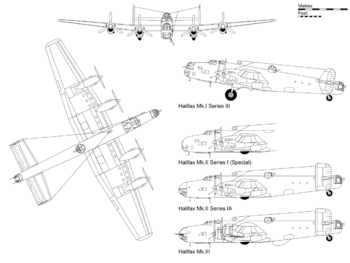
.jpg)
Data from Halifax, Second to None,[45] The Handley Page Halifax B.III, VI, VII[11]
General characteristics
- Crew: 7 (pilot, co-pilot/flight engineer, navigator, bomb aimer, radio operator/gunner, two gunners)
- Length: 71 ft 7 in (21.82 m)
- Wingspan: 104 ft 2 in (31.75 m)
- Height: 20 ft 9 in (6.32 m)
- Wing area: 1,190 sq ft (111 m2)
- Airfoil: root: NACA 23021; tip: NACA 23007[46]
- Empty weight: 37,870 lb (17,178 kg)
- Gross weight: 54,400 lb (24,675 kg)
- Max takeoff weight: 65,000 lb (29,484 kg)
- Powerplant: 4 × Bristol Hercules XVI 14-cylinder air-cooled sleeve-valve radial piston engines, 1,615 hp (1,204 kW) each
- Propellers: 3-bladed constant-speed propellers
Performance
- Maximum speed: 282 mph (454 km/h, 245 kn) at 13,500 ft (4,100 m)
- Combat range: 1,860 mi (2,990 km, 1,620 nmi)
- Service ceiling: 24,000 ft (7,300 m)
- Rate of climb: 750 ft/min (3.8 m/s)
- Wing loading: 45.7 lb/sq ft (223 kg/m2)
- Power/mass: 0.12 hp/lb (0.20 kW/kg)
Armament
- Guns: 8 × .303 in (7.7 mm) Browning machine guns (4 in dorsal turret, 4 in tail turret) and 1 × .303 in (7.7 mm) Vickers K machine gun in the nose.
- Bombs: 13,000 lb (5,897 kg) of bombs
Avionics
- H2S PPI radar
Halifax 57 Rescue
Halifax 57 Rescue is a Canadian organization dedicated to the recovery and restoration of Handley Page Halifaxes. Since its inception in 1994 the organization has recovered two aircraft, including Halifax NA337, one of only three complete examples in the world.
The organization was founded in 1994 by Karl Kjarsgaard, a Canadian former Air Canada pilot, and Ian Foster of Scotland. In 1995 they participated in their first recovery project, that of Halifax NA337 from 750 feet underwater in Lake Mjøsa, Norway. The aircraft was moved to the National Air Force Museum of Canada in Trenton, Ontario where it was unveiled in 2005 after a full restoration.[47] Their second project was the 1997 recovery of Halifax LW682 from a bog near Geraardsbergen, Belgium. During the recovery, the bodies of three crew members were removed and given a proper burial. Several parts of the aircraft were used in the restoration of NA337, and the airframe was melted down and later used to construct the RAF Bomber Command Memorial in London, which was unveiled in 2012.[32]
At present, Halifax 57 Rescue is working to recover two aircraft. The first is HR871, located off the coast of Sweden.[48] Preparations are currently underway for underwater excavation. Once the aircraft has been raised, it will be moved to the Bomber Command Museum of Canada in Nanton, Alberta for restoration. The second aircraft the organization is seeking to recover is LW170 off the coast of Scotland.[49] This aircraft has yet to be located, although its general position is known.[50]
See also
Aircraft of comparable role, configuration and era
- Avro Lancaster
- Boeing B-17 Flying Fortress
- Consolidated B-24 Liberator
- Heinkel He 177
- Petlyakov Pe-8
- Short Stirling
Related lists
Notes
- The aircraft were assembled at Leavesden from components and assemblies manufactured around London
References
Notes
- The first "Thousand bomber raid" on Cologne on 30–31 May 1942 included 131 Halifaxes and 73 Lancasters; The attack on Berlin on 28 February 1943 included 252 Halifaxes and 457 Lancasters; The attack on Hamburg on 27–28 July 1943 included 244 Halifaxes, 353 Lancasters, 116 Stirlings and 74 Wellingtons; The attack on Nuremberg on 30–31 March 1944 included 214 Halifaxes and 572 Lancasters; The attack on Dresden on 13–14 February 1945 included 753 Lancasters and no Halifaxes with nine Mosquitoes marking.
Citations
- Angelucci, Enzo (1988). Combat aircraft of World War II. p. 22. ISBN 0-517-64179-8.
- Norris 1966, p. 3.
- Moyes 1966, p. 3.
- Bingham 1986, p. 4.
- Buttler 2004, p. 104.
- Buttler 2004, p. 102.
- Buttler 2004, p. 105.
- Barnes, C H: Handley Page Aircraft since 1907, London 1976, pp. 387–388.
- Moyes 1966, p. 4.
- Flight pp. 400–401.
- Norris 1966, p. 12.
- Norris 1966, p. 5.
- Johnson, Brian (1982). A Most Secret Place : Boscombe Down 1939–45. pp. Chapter 1.
Recommendations 'The rudder overbalance, which is manifest when both port airscrews are feathered, would cause great fatigue to a pilot attempting to keep straight and level under such conditions, and modification action is necessary in order to overcome this defect.'
- "Halifax aircraft: performance and handling trials: A.& A.E.E/760 13 pts 760a-e 55 pts". 1940–1946. Cite journal requires
|journal=(help) - Barnes 1987,
- Barnes, C H: Handley Page Aircraft since 1907, London 1976, pp. 417, 419, 423, 603.
- Moyes 1966, pp. 3–4.
- Flight 1942, p. 401.
- Falconer 1998, p. 232
- Norris 1966, pp. 4–5.
- Norris 1966, pp. 5–6.
- Lake, Jon. "'Bomber Harris' – an enduring enigma." Archived 2 December 2013 at the Wayback Machine Osprey Publishing, 1 May 2002. Retrieved: 15 September 2013.
- Halifax – Second to none, p. 111. ISBN 0-906393-66-3.
- Norris 1966, p. 6.
- Norris 1966, pp. 6, 8.
- Norris 1966, p. 8.
- Norris 1966, p. 10.
- Norris 1966, pp. 8, 10.
- Norris 1966, p. 9.
- Wings Encyclopedia of Aviation. London: Orbis Publishing, 1979.
- Norris 1966, pp. 9–10.
- "Bomber Command Memorial in London". www.bombercommandmuseum.ca. Retrieved 17 June 2017.
- Lake 1997, p. 131.
- Robertson 1990, p. 77.
- Lake 1997, p. 132.
- Lake 1999, p. 93.
- Lake 1999, pp. 92–93.
- Robertson 1990, pp. 4, rear cover.
- Robertson 1990, p. 64.
- Lake 1999, pp. 91–92.
- Lake 1999, pp. 90–96.
- "The Story of Halifax NA337". airforcemuseum.ca. National Air Force Museum of Canada. Retrieved 17 June 2017.
- "Handley Page Halifax Mk III – Yorkshire Air Museum". Yorkshire Air Museum. Retrieved 17 June 2017.
- "Handley Page Halifax B.MK.II Series I W1048/8465M" (PDF).
- Bingham 1986, p. 170
- Lednicer, David. "The Incomplete Guide to Airfoil Usage". m-selig.ae.illinois.edu. Retrieved 16 April 2019.
- "The Story of Halifax NA337 « National Air Force Museum of Canada". airforcemuseum.ca. Retrieved 17 June 2017.
- "Support the Recovery of a RCAF Halifax Bomber". FundRazr. Retrieved 17 June 2017.
- "Fishing For Halibags – Retrieving a Halifax Bomber from the Irish Sea > Vintage Wings of Canada". www.vintagewings.ca. Retrieved 17 June 2017.
- "Bomber Command Museum of Canada – Halifax Project". www.bombercommandmuseum.ca. Retrieved 17 June 2017.
Bibliography
- Barnes, C. H. Handley Page Aircraft since 1907. London: Putnam, 1987. ISBN 0-85177-803-8.
- Bingham, Victor F (1986). Halifax, Second to None: The Handley Page Halifax. Airlife. ISBN 0-906393-66-3.CS1 maint: ref=harv (link)
- Buttler, Tony. British Secret Projects: Fighters & Bombers 1935–1950. Hinckley: Midland Publishing, 2004. ISBN 1-85780-179-2.
- Clarke, R. M., ed. Handley Page Halifax Portfolio. Cobham, Surrey, UK: Brooklands Books, No year cited. ISBN 0-948207-89-2.
- Clayton, Donald C. Handley Page: An Aircraft Album. Shepperton, Surrey, UK: Ian Allan Ltd., 1970. ISBN 0-7110-0094-8.
- Jones, Geoffrey Patrick. Night Flight: Halifax Squadrons at War. London: William Kimber, 1981. ISBN 0-7183-0338-5.
- Falconer, Jonathan. Bomber Command Handbook 1939–1945. Stroud, England:Sutton Publishing, 1998. ISBN 0-7509-3171-X.
- Lake, Jon (1999). Halifax Squadrons of World War 2. Osprey Publishing. ISBN 1-85532-892-5.CS1 maint: ref=harv (link)
- Lake, Jon (1997). Halifax Variants. Wings of Fame, Vol. 8. Aerospace Publishing. ISBN 1-86184-009-8.CS1 maint: ref=harv (link)
- Merrick, Keith A. Halifax, an Illustrated History of a Classic World War II Bomber. Shepperton, Surrey, UK: Ian Allan, 1980. ISBN 0-7110-0767-5.
- Merrick, Keith A. Handley Page Halifax: From Hell to Victory and Beyond. Hersham, Surrey, UK: Ian Allan Publishing, 2009. ISBN 978-1-906537-06-7.
- Merrick, Keith A. The Handley Page Halifax. Bourne Ends, Buckinghamshire, UK: Aston Publications, 1990. ISBN 978-0-946627-60-8.
- Moyes, Philip J.R. Handley Page Halifax: Merlin-Engined Variants (Aerodata International No 7). Kidlington. Oxfordshire, UK: Vintage Aviation Publications, 1979. ISBN 0-905469-50-X.
- Moyes, Philip J.R. The Handley Page Halifax B.III, VI, VII. Leatherhead, Surrey, UK: Profile Publications, 1966.
- Norris, Geoffrey. The Short Stirling, Aircraft in Profile Number 142. Windsor, Berkshire, UK: Profile Publications Ltd., 1966.
- Rapier, Brian J. Halifax at War. Shepperton, Surrey, UK: Ian Allan, 1987. ISBN 0-7110-1554-6.
- Roberts, Nicholas (1979). Aircraft Crash Log No.2: Handley Page Halifax.CS1 maint: ref=harv (link)
- Roberts, R. N. (1982). The Halifax File. Air Britain (Historians). ISBN 0-85130-098-7.
- Robertson, B (1990). Halifax Special. Ian Allan. ISBN 0-7110-1920-7.CS1 maint: ref=harv (link)
- Robinson, Ian (1996). The Unbeaten Warrior Returns: The Story of Reconstructing the Handley Page Halifax at the Yorkshire Air Museum, 1983–96. Yorkshire Air Museum. ISBN 0-9512379-4-2.CS1 maint: ref=harv (link)
- Scutts, Jerry. Halifax in Action (Aircraft in Action series, No. 66). Carrollton, TX: Squadron/Signal Publications, Inc., 1984. ISBN 0-89747-158-X.
- Stachiw, Anthony L. and Andrew Tattersall. Handley Page Halifax: In Canadian Service St. Catharine's, Ontario, Canada: Vanwell Publishing, 2005. ISBN 1-55125-085-3.
- "The Halifax". Flight. flightglobal.com archive. 23 April 1942. Retrieved 10 December 2011.
Videography
- Halifax at War: The Story of a Bomber (76 min. DVD). Toronto: Nightfighters Productions, 2005. ISBN 1-55259-571-4.
External links
| Wikimedia Commons has media related to Handley Page Halifax. |
- Photo tour of the Elvington Halifax
- Handley Page Halifax II (III) at Yorkshire Air Museum
- One of the Many The story of a 76 Squadron Flight Engineer and his Halifax aircraft in World War II
- Krentz, Herbert. To Hell in a Halifax (2006) ISBN 9780978035808 – the true story of RCAF pilot Herbert Krentz, the sole survivor when his Halifax Mk V was shot down over Germany in early 1944
- Halifax at the International Bomber Command Centre Digital Archive, University of Lincoln